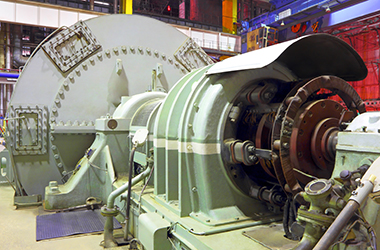Main Menu
 The Static Exciter Ground Fault Detector Model AT-8100 provides continuous wireless monitoring of insulation fault resistance and field
voltage on brushed exciter generator and motor field windings, combining advanced ground fault measurement techniques with the latest innovations in digital telemetry. The system also provides users with condition monitoring data, allowing operators
to monitor trends over time in order to make better informed operational and maintenance decisions.
The Static Exciter Ground Fault Detector Model AT-8100 provides continuous wireless monitoring of insulation fault resistance and field
voltage on brushed exciter generator and motor field windings, combining advanced ground fault measurement techniques with the latest innovations in digital telemetry. The system also provides users with condition monitoring data, allowing operators
to monitor trends over time in order to make better informed operational and maintenance decisions.
Accumetrics’ Static Exciter Rotor Ground Fault Detector Model AT-8100 provides statically excited field ground fault detection technology. Building on the success of the Accumetrics’ Earth Fault Resistance Monitoring Systems for brushless generator designs, the Rotor Ground Fault Detector system provides continuous on-line monitoring for brushed-style excitation generators and motors.
Conventional field ground detectors may detect the occurrence of faults but provide no advance warning or indication of the fault’s severity. In fact, the severity at the detection threshold may vary by several orders of magnitude, depending on fault location. Now, by combining 16-bit digital measurement technology with the most sophisticated technique available for generator ground fault measurements, Accumetrics overcomes these limitations with the Static Exciter Rotor Ground Fault Detector Model AT-8100.
Measurement of actual resistance allows users to monitor trends over time and track the progression of ground faults from their onset. This provides an early warning of impending failure and allows for predictive maintenance of a machine. Ground fault severity data can be used to make operational and maintenance decisions. In addition, the technique yields a location factor, which indicates where the fault occurs along the length of the field winding.
| Specifications | |
|---|---|
| Rotor Connections | Field Positive Terminal |
| Field Negative Terminal | |
| Rotor Earth/Ground | |
| Field Voltage | |
| Measurement Range | 0 to 500 VDC (contact factory for other ranges) |
| Maximum Transient without Damage | 1000 V for 5 seconds |
| Resistance Measurement | |
| Measurement Range | 0 to 80 MΩ |
| Accuracy | ±250 Ω ±0.5% of Reading 0 to 500 kΩ (exclusive of the effects of AC content and noise from the excitation system) |
| Ground/Earth Fault Location Factor | |
| Range | 40 to 100% representing ratio of potential at fault to total field voltage (0 at negative terminal and 100% at positive terminal) |
| Accuracy | ±1% for a 10 kW fault and field excitation ≥25 V |
| Receiver Alarm Outputs | |
| Ground/Earth Fault | Two independent alarm resistances, user selectable via computer interface from 500 W to 1 MΩ |
| Malfunction | Active upon detection of a malfunction in monitor operation or loss of receiver power |
| Alarm Interfaces | Form C relay: 10 A / 24 VDC, 0.3 A / 240 VDC, 10 A / 250 VAC resistive |
| Receiver Analog Outputs | |
| Analog Outputs | Dual analog output of Fault Location, Log Resistance (4-20 mA) |
| Receiver Digital Interface | |
| Computer Interfaces | RS232, Ethernet |
| Output Data | Ground/Earth Fault Resistance, Field Voltage, Location Factor when faults occur, Alarm and error conditions |
| User Settings | Ground/Earth Fault Alarm Resistance Thresholds, Alarm Dwell Time, Network Settings |
| Environment | |
| Ambient Temperature | 0 °C to 50 °C |
| System Power | |
| 85 VAC to 250 VAC 50/60 Hz, < 20 W | |